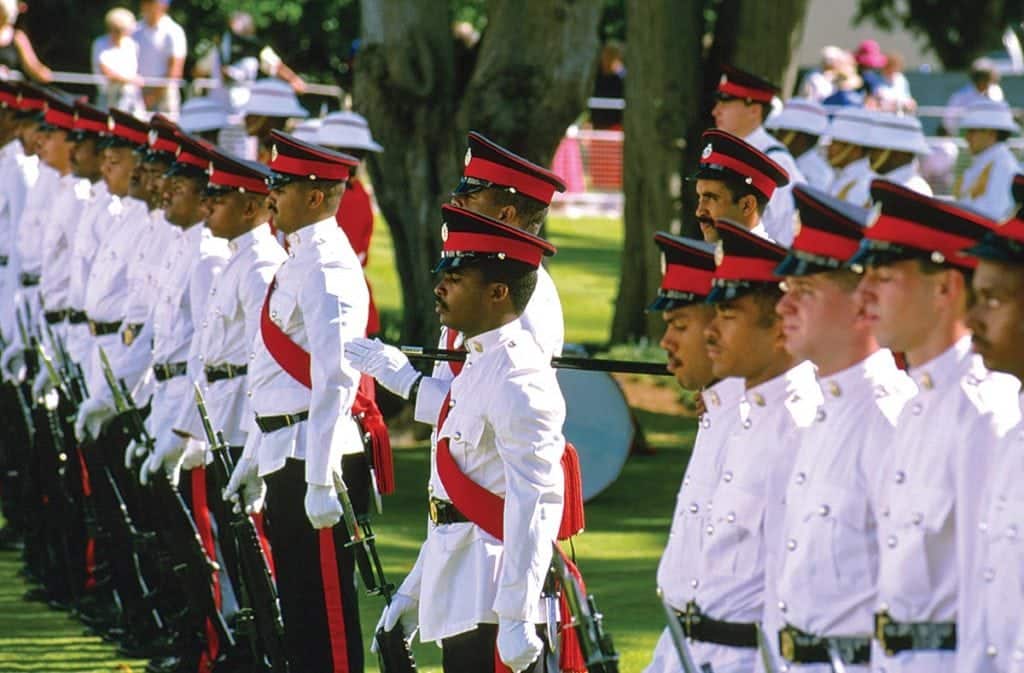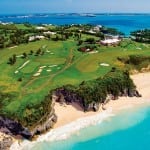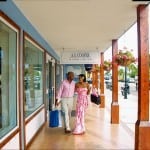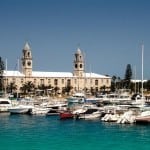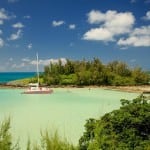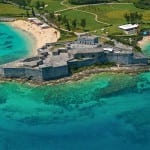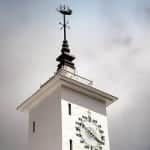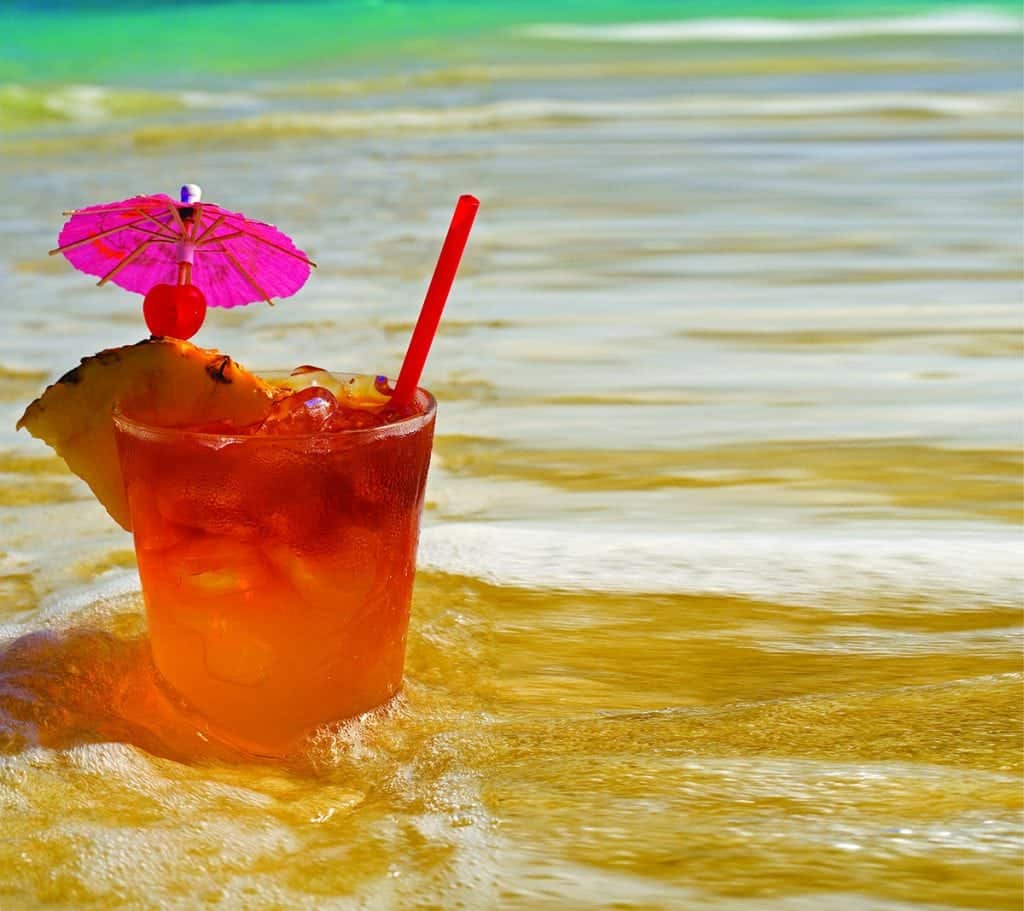Royal Regattas, Majestic Marlin
An enormous fishhook named Bermuda appears on the Atlantic Ocean approximately 650 miles off the U.S. coast. Although blue-green waters surrounding its pink shores are inviting, its treacherous reefs have caught over 300 ships in 5 centuries. Shakespeare’s The Tempest tells the tale of the British vessel Sea Venture, which fell victim to the Isle of Devils while battling a hurricane in 1609. She carried supplies to starving Jamestown, Virginia, when Captain Somers beached her and saved all 150 onboard, who then survived by fishing the island’s bountiful seas. They enjoyed a warm climate—compliments of the Gulf Stream—and skillfully built ships out of cedar, thus beginning Bermuda’s status as a major maritime center. The British Navy built an outpost, the Royal Naval Dockyard, and several forts there to protect colonial interests in the Caribbean and America after Bermudian blockade-runners invaded several U.S. waterways. Due to the Bermuda Sloop rig’s innovative triangular sails, Bermudian ships would scurry past square-riggers close on the wind. Smaller versions of these ships called Bermuda Fitted Dinghies filled Hamilton Harbor during island regattas—they still sail there today.
World-class racing yachts join them in June when the Newport to Bermuda Race—the oldest regularly scheduled ocean race—takes place. Run biannually by the Cruising Club of America and Royal Bermuda Yacht Club, this year’s race was its 49th since its start in 1906. Yachts sail 635 miles from Newport, Rhode Island, to Bermuda, crossing challenging Gulf Stream currents as described by the race’s first winner, Thomas Fleming Day, who said, “You don’t stop to parlay with a Gulf Stream in June.” The Royal Bermuda Yacht Club clears its docks for over 150 boats after they pass Gibb’s Hill Light, maneuver Town Cut channel and check through customs in St. George’s. Last year 37,000 shots of Bermuda’s Gosling’s rum were served to 4,000 partygoers. Silver trophies in the shape of Bermuda’s aids to navigation are awarded to top skippers and crews, with the grand prize being the highly coveted St. David’s Light trophy. The longevity and success of this historic race is, perhaps, the main reason behind Bermuda being considered as a venue for the 35th America’s Cup in 2017.
In 2014, with June’s sailing events spent, July brings sport fishing to the island with the Bermuda Triple Crown. The 10-year-old premier Atlantic marlin competition is three major billfish tournaments in one: The Bermuda Billfish Blast July 3-7; the Bermuda Big Game Classic July 9-13; and the Sea Horse Anglers Club Billfish Tournament July 16-20. During The Bermuda Billfish Blast on July 4th, anglers cast lines simultaneously with others around the globe in hopes of catching the day’s biggest marlin caught in the Blue Marlin World Cup. A 768-pound blue marlin won it for Bermuda’s Queen of Hearts last year. The largest marlin ever caught in the series was reeled in by Southern Exposure in 2005 weighing a whopping 1,023 pounds. The biggest single cash prize ever awarded was $400,000. Profits can be made since competition costs average $33,000. Last year thirty-six teams from the U.S., Canada and Bermuda competed, and even more are expected this year with the sponsoring Fairmont Hamilton Princess Hotel’s new marina.
The ever-so-pink Fairmont Hamilton Princess—where The Triple Crown trophies are divvied out—overlooks the harbor in Bermuda’s capital city. The “Pink Palace”—where Bermuda does business—opened its doors in 1885 as a posh hotel for affluent Americans, and a statue of its frequent guest, Mark Twain, sits on a bench in the lobby. Ian Fleming used its Gazebo Bar as a setting in the James Bond film Dr. No.
High Tea in its Heritage Court is an elegant indulgence. The hotel has recently experienced a $90-million redevelopment that includes a state-of-the-art marina that opens this month. It has 60 permanent berths for Bermudians with several for visiting boats up to the size of superyachts. As Bermuda’s only full-service marina, it offers integrated pump-out facilities, floating docks and full-length finger piers. Hotel amenities including provisioning are available to visiting yachts.
The Pompano Beach Club began as Bermuda’s first fishing club in the 1950s as a small fishing lodge that took guests on daily deep-sea fishing trips, then served the day’s catch in its dining room that evening. Generations of the Lamb family upgraded it to a more luxurious resort that’s known for its attentive service. The Club still remembers its roots, however, and arranges sport fishing for visiting anglers staying at resort villas that are named after local game fish. Guests can watch stingrays swoop through shallow waters below and white long-tailed seabirds circle above their balconies. All rooms enjoy a sunset view over the ultra-blue Atlantic.
Yachts sailing the Atlantic bound for Europe, the Caribbean and the U.S. visit Bermuda as a convenient stopover. In 2004, the first motor-cruising flotilla made a historic Atlantic crossing when 18 trawler yachts departed Fort Lauderdale, Florida, and cruised over 1,800 miles to the Azores. The Nordhavn Atlantic Rally enjoyed their midpoint with a weeklong stay at Royal Bermuda Yacht Club, where captains and crew took their dinghies into bays and reefs for snorkeling and wreck diving in 80-degree, crystal clear water. On land, they rented scooters to explore the sights, restaurants, and pubs of the Royal Naval Dockyard, the town of Hamilton, and Bermuda’s original settlement, St. George’s. The island’s efficient bus and ferry system is also a fun and affordable way to connect the dots—ticket books are readily available. Royal Naval Dockyard houses the National Museum of Bermuda that conveys Bermuda’s maritime importance, including the Sea Venture shipwreck, cruise ships, indigenous fishing gear, and boats such as the fitted dinghy on display. Hamilton’s Front Street shops offer everything from Gosling’s rum to Irish linens. St. George’s is a UNESCO World Heritage Site with fine examples of 17th-century Bermudian buildings capped with white-stepped roofs for collecting drinking water.
Getting to this beautiful and historic island may seem daunting with its reefs, but shipwrecks seldom occur now. However, the reefs do extend 10 miles out to the north and west, and along all channels and inland bays. As always, local charts should be studied carefully and eyeball navigation is necessary for narrow passages. Visiting international yachts are only permitted to approach Bermuda from the east end of the island since immigration and customs are located in St. George’s. St. David’s Light is a recognizable local fix and Town Cut, the channel to St. George’s, is easily identified both night and day. Several existing marinas and another one in the works, a dinghy club and some pleasant anchorages are nearby. Online customs and immigrations forms, navigation tips, marine services and weather information can be found at marineandports.bm.
By Nancy Spraker, Southern Boating July 2014


